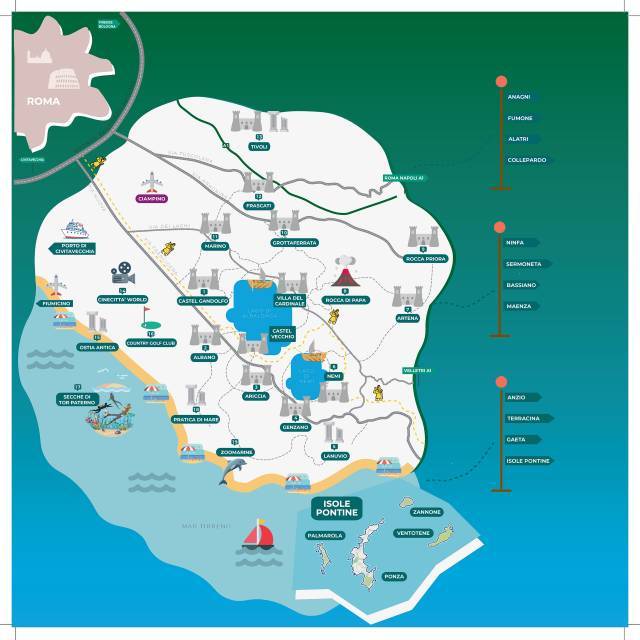HOTEL CASTEL VECCHIO
ATTRACTIONS
your experience in the Roman Castles
CASTELLI ROMANI
The Roman Castles offer many opportunities for unforgettable day trips focused on nature, art, and gastronomy.
The Alban Hills, with the lakes of Castel Gandolfo and Nemi, originate from a vast volcanic complex known as the Latium Volcano.
The "historic" towns of the Roman Castles are: Castel Gandolfo, Rocca di Papa, Albano, Ariccia, Frascati, Genzano, Grottaferrata, Lanuvio, Marino, Nemi, and Velletri.
During the late Republican era, the entire area saw the settlement of numerous Roman domus.
Later, from the 1600s, the "castles" of the Barberini, Colonna, Chigi, Ruspoli, Sforza Cesarini, and Aldobrandini princes were built on the ruins of ancient patrician residences.

ROMAN CASTLES
between History and Legend
Myth tells that Ascanius, son of Aeneas, after the fall of Troy (12th century BC), founded the city of Alba Longa on the shores of Lake Albano, the vibrant heart of the Alban Hills.
Alba Longa led the Latin League, an alliance of the cities of Latium Vetus, whose symbolic center was the sanctuary of Iuppiter Latialis, erected at the summit of Mount Albanus (today's Monte Cavo). Each year, representatives of the League gathered to celebrate the Feriae Latinae, festivals dedicated to Jupiter Latiaris: they would process along the Via Sacra, ascend Mount Albanus, and, upon reaching the deity's temple, sacrifice a great white bull to renew their alliance.
For centuries, Aeneas' descendants peacefully succeeded each other on the throne of Alba Longa, solidifying the city's hegemony over ancient Latium. However, upon the death of King Proca, the rightful heir Numitor was dethroned by his brother Amulius, who, to secure his reign, killed Numitor's male heirs and forced his only daughter, Rhea Silvia, to become a Vestal Virgin.
Nevertheless, the priestess, seduced by the god Mars, broke her vow of chastity and gave birth to twin sons: Romulus and Remus. Kidnapped and abandoned on the River Aniene by Amulius' order, the twins were saved and suckled by the legendary she-wolf, later being taken in and raised by a shepherd couple: Faustulus and Acca Larentia.
When Romulus and Remus, now adults, discovered their noble origins, they decided to act against Amulius and restore their grandfather Numitor to the throne of Alba Longa. After killing Amulius and returning the kingdom to its rightful ruler, the twins received permission to found a new city along the banks of the Tiber River: Rome.
MUSEUMS
Culture and territory
MUSEUM OF ROMAN SHIPS OF NEMI
The museum was built between 1933 and 1939 to house the "temple-ship" and the "palace-ship" of Emperor Caligula (37-41 AD), recovered from the waters of Lake Nemi between 1929 and 1931. The left wing is dedicated to the ships, showcasing their remains, while the right wing is dedicated to the settlement of the Alban territory during the Republican and Imperial eras.
For information and reservations:
www.polomusealelazio.beniculturali.it
CIVIC MUSEUM OF LANUVIO
The museum's exhibition spaces house a pre-Roman and Roman section dedicated to the most significant artifacts and monuments of ancient Lanuvium. One room is entirely dedicated to the Votive Deposit of Pantanacci, discovered near the Temple of Juno Sospita. The votive offerings of Pantanacci, unique in the world, depict eyes, ears, hands, feet... anatomical parts for which devotees implored healing.
For information and reservations:
www.comune.lanuvio.rm.it
BOOK NOW




